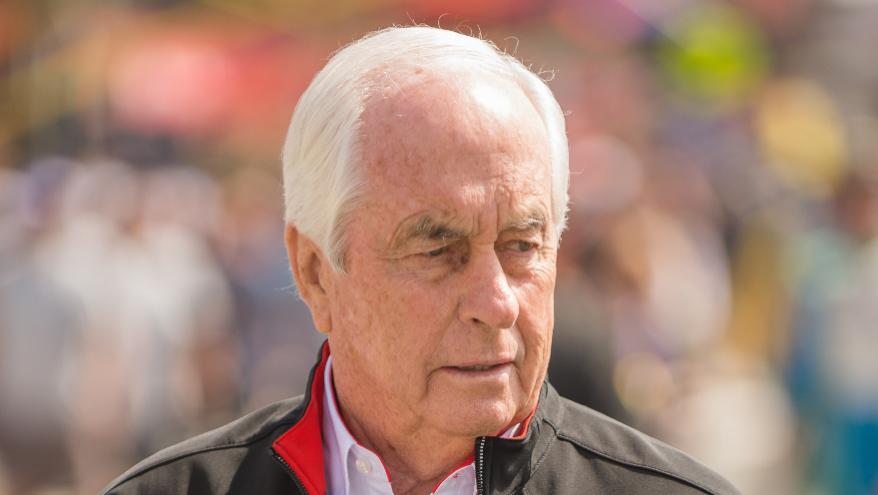Used vehicles help Penske achieve diversification, record earnings

2014 photo of Roger Penske at a NASCAR event. Editorial credit: action sports / Shutterstock.com
Record earnings, the role of diversification in achieving those earnings and the prominence of used vehicles as part of that diversification were among the main themes of the Penske Automotive Group third quarter 2018 earnings results.
PAG and its chairman and CEO Roger Penske reported during the results call on Oct. 25 that the record quarter was driven by diversification, and the company’s standalone used-vehicle supercenters helped lead the way in that diversity, along with Penske heavy-duty truck dealerships and truck leasing investments.
Roger Penske expanded on the strength of used vehicles during the question-and-answer period at the end of the results call, noting that consolidated reconditioning locations and double discounting played a role in the company’s record earnings.
“Double discounting means you have an Internet price, someone comes in on an Internet price, and the first thing your salesperson does is give him a discount,” Penske said. “So, I think it’s managing your team. Double discounting has really helped us to maintain our used, and both new and used gross profit as you’ve seen that increase during the quarter.”
PAG’s earnings results were mostly positive all around. For the three months ended Sept. 30, 2018, income from continuing operations attributable to common shareholders increased 38.0 percent to a record $130.1 million, and related record earnings per share increased 39.1 percent to $1.53 when compared to the same period last year.
Total revenue of $5.7 billion represented an increase of 2.4 percent, while same-store retail revenue increased 0.2 percent.
Roger Penske elaborated on the benefits of diversification in a quote from the press release that accompanied the earnings report, noting that the strong earnings in the quarter were due to increases in new-vehicle, used-vehicle and finance and insurance gross profit per retail unit sold, along with a 70-basis-point increase in service and parts gross margin.
He also gave attention to the strength of the company’s standalone used-vehicle supercenter operations in the U.K., stating that the supercenters, along with Penske’s premium brand mix, helped contribute to another record quarter for the company’s U.K. business.
Supercenter strength
Further emphasizing the importance of the company’s used-vehicle supercenters during the earnings call, Roger Penske noted that the company expects to retail nearly 70,000 vehicles through the supercenters in 2018, and they will generate about $1.2 billion in revenue.
He added that the five supercenters in the U.S. and nine in the U.K. use a one-price, no-haggle approach. Year-to-date, the standalone used dealerships retailed 56,000 units and generated $1 billion in revenue and a return on sales of approximately 3.9 percent. Penske noted during the earnings call that the average transaction price is $15,000, and the variable gross profit per unit is almost $2,200, for a variable gross margin of 14.5 percent.
The revenue mix for these stores is 84 percent used vehicles, 9 percent wholesale, 6 percent F&I, and 1 percent service and parts. Gross profit contribution is 42 percent used, 2 percent wholesale, 39 percent F&I, and 17 percent service and parts.
“We expect to grow the standalone used business through a combination of e-commerce initiatives and new market introductions,” Penske said. “We're in the process of developing four new standalone sites, which we expect to open in the latter half of 2019.”
He discussed how his company sourced used vehicles in response to a question from an earnings call participant. Penske noted that trade-ins were “the first level of acquisition of used,” followed by auctions. Internet purchases were another sourcing method.
“And then, there’s a tremendous amount of lease returns coming back … not only in ’17 (and) ’18 but beyond into ’19,” he said. “We have the opportunity to make big purchases on those. In fact, in the U.K., I know they buy sometimes between 1,000 and 1,500 vehicles at a time, which gives them very good pricing and a broad mix of vehicles, so those would be the key areas of acquisition.”
Technology was another main theme of the earnings call. Roger Penske went on to discuss the technology in use at the used-car supercenters in the U.S. and U.K., and a presentation accompanying the earnings report noted that certain U.K. standalone used-vehicle supercenters allow customers to reserve a vehicle online. That technology has allowed the company to use the fundamentals of determining what it buys at what price and for what location.
“I think with the technology they developed, and this is in-house, it’s given us the ability to buy the right vehicle to give us the turn on our inventory,” Penske said.
Another questioner asked Penske if PAG could double the revenue of its standalone used-vehicle business in the next two to three years. Penske answered that although acquisitions are not currently at the top of the company’s list at the moment, “acquisitions, plus organic growth, plus the new sites will give us a chance to double that revenue.”
Going back to the opening remarks, Penske concluded his remarks by noting that in a strong U.S. economy and with the strength of the business’ premium and luxury automotive brand mix, the continued strength of the class 8 heavy-duty truck market in North America, the growing standalone used vehicle operation, and the benefits PAG continues to receive from its truck leasing investments, “We remain confident and optimistic about the future of our business.”

 View The Latest Edition
View The Latest Edition

